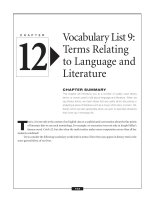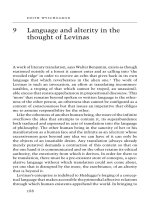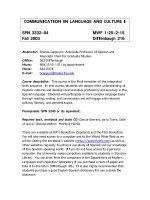Ebook Language and Linguistics
Bạn đang xem bản rút gọn của tài liệu. Xem và tải ngay bản đầy đủ của tài liệu tại đây (2.04 MB, 393 trang )
LANGUAGE AND LINGUISTICS
The new edition of this highly successful A–Z guide explores the
main concepts and terms used in the study of language and lin-
guistics. Containing over 300 entries, thoroughly updated to reflect
the latest developments in the field, this book includes entries in:
Cognitive linguistics
Discourse analysis
Phonology and phonetics
Psycholinguistics
Sociolinguistics
Syntax and semantics
Beginning with a brief definition, each entry is followed by a com-
prehensive explanation of the origin and usage of the term. The
book is cross-referenced throughout and includes further reading
for academics and students alike.
R.L. Trask (1944–2004) was the highly regarded Professor of Lin-
guistics at the Uni versity of Sussex. His numer ous publications inclu-
ded Language: The Basics (1995) and A Dictionary of Phonetics and
Phonology (1995).
Peter Stockwell is Professor of Literary Linguistics at the University
of Nottingham and the editor of the Routledge English Language
Introductions Series.
YOU MAY ALSO BE INTERESTED IN THE
FOLLOWING ROUTLEDGE STUDENT
REFERENCE TITLES
Language: The Basics (Second Edition)
R.L. Trask
Semiotics: The Basics
Daniel Chandler
Psycholinguistics: The Key Concepts
John Field
The Routledge Companion to Semiotics and Linguistics
Paul Cobley
LANGUAGE AND
LINGUISTICS
The Key Concepts
Second Edition
R.L. Trask
Edited by Peter Stockwell
First published as Key Concepts in Language and Linguistics 1999
This edition published 2007
by Routledge
2 Park Square, Milton Park, Abingdon, Oxon OX14 4RN
Simultaneously published in the USA and Canada
by Routledge
270 Madison Avenue, New York, NY 10016
Routledge is an imprint of the Taylor & Francis Group, an informa business
First edition text # 1999 R.L. Trask
Second edition # 2007 R.L. Trask and Peter Stockwell
All rights reserved. No part of this book may be reprinted or reproduced or utilized
in any form or by any electronic, mechanical, or other means, now known or
hereafter invented, including photocopying and recording, or in any information
storage or retrieval system, without permission in writing from the publishers.
British Library Cataloguing in Publication Data
A catalogue record for this book is available from the British Library
Library of Congress Cataloging in Publication Data
A catalog record for this book has been requested
ISBN 978-0-415-41358-9 (hbk)
ISBN 978-0-415-41359-6 (pbk)
ISBN 978-0-203-96113-1 (ebk)
This edition published in the Taylor & Francis e-Library, 2007.
“To purchase your own copy of this or any of Taylor & Francis or Routledge’s
collection of thousands of eBooks please go to www.eBookstore.tandf.co.uk.”
ISBN 0-203-96113-7 Master e-book ISBN
CONTENTS
List of Key Concepts (alphabetically arranged) vi
List of Key Concepts (arranged by linguistic sub-discipline) xi
Preface to the revised edition xviii
The International Phonetic Alphabet xxi
KEY CONCEPTS 1
Bibliography 330
Index 351
v
ALPHABETICAL LIST OF
KEY CONCEPTS
(Listed alphabetically, as they appear in this book)
accent
adjacency pair
adjective
adverb
affix
affricate
agreement
airstream mechanism
alternation
ambiguity
analogy
anaphor
animal communication
anthropological linguistics
aphasia
apparent time
applied linguistics
arbitrariness
argument
artificial language
aspect
autolexical grammar
autonomy
auxiliary
basic word order
behaviourism
bilingualism
bioprogram hypothesis
Black English
borrowing
case
clause
clitic
cloze
code-switching
cognitive linguistics
cohesion
colligate
communicative competence
community of practice
comparative reconstruction
competence
complement
computational linguistics
conceptual integration
conjunction
connotation
consonant
constituent structure
construction grammar
control
conversation analysis
conversational implicature
cooperative principle
coordinate structure
copula
creole
critical discourse analysis
critical period hypothesis
dead language
vi
deep structure
deficit hypothesis
deictic category
denotation
dependency
derivation
descriptivism
design features
determiner
diachrony
dialect
diglossia
direct object
discourse
discourse analysis
displacement
distinctive feature
distribution
duality of patterning
dyslexia
elicitation techniques
ellipsis
entailment
ethics
ethnicity
ethnography of
communication
etymology
euphemism
finite
focus
folk linguistics
foregrounding
forensic linguistics
formal grammar
frame
functionalism
functions of language
gap
gender
generative grammar
genetic hypothesis of language
genetic relationship
genre
given/new
government
Government-and-Binding
Theory
grammar
grammatical category
grammatical relation
grapheme
head
historical linguistics
iconicity
identity
ideology
idiom
indicator
indirect object
Indo-European
infinitive
inflection
innateness hypothesis
integrationalism
internal reconstruction
international language
International Phonetic
Alphabet
intertextuality
intonation
intuition
irrealis
kinship terms
landmark
language
language acquisition
language acquisition device
language areas
language change
language contact
language death
language disability
language faculty
ALPHABETICAL LIST OF KEY CONCEPTS
vii
language family
language instinct
language myths
language planning
language processing
langue
lateralization
lemma
Lexical-Functional Grammar
lexicography
lexicon
lingua franca
linguistic area
linguistic relativity hypothesis
linguistic sign
linguistics
literacy
loan word
localization
logonomic rules
manner of articulation
markedness
markers
meaning
medium
mental space
mentalism
metalanguage
metaphor
minimal pair
minimalist program(me)
minority language
mirror neurons
modality
modifier
mood
morpheme
morphology
motherese
movement
name
narrative
national language
natural class
natural-language processing
neurolinguistics
neutralization
nominalization
non-verbal communication
notational convention
noun
noun phrase
number
number of languages
observer’s paradox
official language
onomastics
open-endedness
optimality theory
oracy
origin and evolution of
language
orthography
paradigm
paradigmatic relation
paralanguage
parole
parsing
part of speech
perceptual strategy
performance
performative
person
philology
philosophy of language
phonation type
phoneme
phonetics
phonology
phonotactics
phrase
phrase-structure grammar
pidgin
place of articulation
ALPHABETICAL LIST OF KEY CONCEPTS
viii
politeness
polysynthesis
possible worlds theory
power
pragmatics
predicate
preposition
prescriptivism
prestige
presupposition
productivity
pronoun
prosody
proto-language
proto-language hypothesis
prototype
psycholinguistics
punctuation
purism
qualitative approach
quantitative approach
raising
rank scale
reconstruction
recursion
reference
relevance
rhetoric
root
rule
Saussurean paradox
schema
segment
selection restriction
semantic role
semantics
semiotics
sense
sense relation
sentence
sex differences in language
sexist language
sign language
slang
social history of language
social network
social stratification of language
sociolinguistics
sound symbolism
speech
speech act
speech community
speech event
speech sound
speech therapy
spelling
standard language
stem
stereotype
stimulus-freedom
stress
structuralism
structure
structure-dependence
stylistics
subcategorization
subject
subordination
suprasegmental
surface structure
syllable
symbolic system
synchrony
syntactic category
syntagmatic relation
syntax
system
systematic correspondence
Systemic Linguistics
tagmemics
tense
text
text linguistics
text world theory
ALPHABETICAL LIST OF KEY CONCEPTS
ix
textuality
tone language
topic
traditional grammar
trajector
transcription
transformational grammar
transitivity
tree
trope
turn-taking
typology
universal
universal grammar
usage
utterance
variable
variation
verb
verb phrase
vernacular
vocal tract
voice
voicing
vowel
well-formedness
word
word-formation
writing system
X-bar
ALPHABETICAL LIST OF KEY CONCEPTS
x
LIST OF KEY CONCEPTS
(Arranged accor ding to the linguistic sub-discipline: some items therefor e
appear repeatedly)
Phonetics and phonology
accent
affricate
airstream mechanism
alternation
consonant
distinctive feature
distribution
grapheme
iconicity
International Phonetic
Alphabet
intonation
lateralization
manner of articulation
markedness
medium
minimal pair
neutralization
notational convention
phonation type
phoneme
phonetics
phonology
phonotactics
place of articulation
prosody
rule
segment
sound symbolism
speech
speech sound
stress
suprasegmental
syllable
tone language
transcription
vocal tract
voice
voicing
vowel
Morphology
affix
aspect
case
copula
derivation
finite
grammar
grammatical category
grammatical relation
grapheme
infinitive
inflection
markedness
morpheme
morphology
paradigm
paradigmatic relation
person
polysynthesis
xi
pronoun
root
rule
spelling
stem
syllable
tense
word
word-formation
Lexicology
aspect
case
clitic
colligate
copula
derivation
determiner
idiom
infinitive
inflection
irrealis
kinship terms
lemma
lexicography
lexicon
loan word
modality
modifier
noun
orthography
predicate
preposition
pronoun
verb
word
word-formation
Syntax
adjective
adverb
agreement
anaphor
aspect
auxiliary
basic word order
case
clause
clitic
complement
conjunction
constituent structure
control
coordinate structure
deep structure
dependency
derivation
determiner
direct object
distribution
ellipsis
finite
frame
gap
given/new
government
grammar
grammatical category
grammatical relation
head
iconicity
indirect object
infinitive
intuition
markedness
modality
modifier
mood
movement
nominalization
notational convention
noun
noun phrase
LIST OF KEY CONCEPTS
xii
number
paradigm
paradigmatic relation
parsing
part of speech
person
phrase
phrase-structure grammar
predicate
preposition
pronoun
raising
recursion
root
rule
sentence
structure
subcategorization
subject
subordination
surface structure
syntactic category
syntagmatic relation
syntax
tense
topic
transformational grammar
transitivity
tree
verb
verb phrase
X-bar
Semantics and pragmatics
ambiguity
analogy
anaphor
arbitrariness
argument
aspect
clause
cohesion
colligate
connotation
conversational implicature
copula
deictic category
denotation
entailment
euphemism
focus
frame
gender
given/new
iconicity
idiom
irrealis
kinship terms
lemma
linguistic sign
markedness
meaning
metaphor
modality
mood
name
paralanguage
politeness
possible worlds theory
power
pragmatics
presupposition
prototype
reference
relevance
selection restriction
semantic role
semantics
sense
sense relation
speech
stereotype
transitivity
LIST OF KEY CONCEPTS
xiii
trope
usage
utterance
verb
verb phrase
Text and discourse analysis
adjacency pair
anaphor
clause
cohesion
cooperative principle
discourse
discourse analysis
ellipsis
focus
frame
functionalism
genre
intertextuality
logonomic rules
narrative
natural-language processing
non-verbal communication
oracy
politeness
possible worlds theory
rank scale
rhetoric
schema
semiotics
speech
speech act
speech community
speech event
stylistics
Systemic Linguistics
text
text linguistics
text world theory
textuality
topic
turn-taking
usage
utterance
writing system
Applied linguistics and
sociolinguistics
accent
aphasia
apparent time
applied linguistics
bilingualism
bioprogram hypothesis
Black English
cloze
code-switching
colligate
community of practice
computational linguistics
conversation analysis
creole
critical discourse analysis
deficit hypothesis
dialect
diglossia
elicitation techniques
ethics
ethnicity
ethnography of communication
forensic linguistics
gender
identity
ideology
indicators
international language
International Phonetic
Alphabet
kinship terms
language change
language contact
LIST OF KEY CONCEPTS
xiv
language death
lingua franca
linguistic area
literacy
markers
minimal pair
minority language
motherese
narrative
national language
number of languages
observer’s paradox
official language
oracy
parole
performance
performative
pidgin
politeness
power
prestige
sex differences in language
sexist language
sign language
slang
social history of language
social network
social stratification of
language
sociolinguistics
speech community
speech therapy
standard language
stereotype
synchrony
tone language
transcription
turn-taking
usage
variable
variation
vernacular
Psycholinguistics and cognitive
linguistics
bilingualism
cloze
cognitive linguistics
communicative competence
competence
conceptual integration
critical period hypothesis
deictic category
dyslexia
foregrounding
frame
given/new
irrealis
landmark
language acquisition
language acquisition device
language areas
language disability
language faculty
language instinct
language planning
language processing
literacy
localization
mental space
mentalism
metaphor
mirror neurons
motherese
natural-language processing
neurolinguistics
oracy
perceptual strategy
possible worlds theory
prototype
psycholinguistics
qualitative approach
quantitative approach
schema
speech therapy
LIST OF KEY CONCEPTS
xv
text world theory
trajector
Historical linguistics and
philology
borrowing
comparative reconstruction
dead language
diachrony
etymology
genetic relationship
grapheme
historical linguistics
Indo-European
internal reconstruction
language change
language contact
language death
language family
loan word
onomastics
origin and evolution of
language
orthography
philology
proto-language
proto-language hypothesis
punctuation
reconstruction
social network
standard language
typology
writing system
Theoretical linguistics and
aspects of language theory
animal communication
anthropological linguistics
arbitrariness
artificial language
autolexical grammar
autonomy
behaviourism
construction grammar
critical period hypothesis
descriptivism
design features
displacement
duality of patterning
folk linguistics
forensic linguistics
formal grammar
functionalism
functions of language
generative grammar
genetic hypothesis of language
Government-and-Binding
Theory
innateness hypothesis
integrationalism
language
language myths
langue
Lexical-Functional Grammar
linguistic relativity
linguistics
mentalism
metalanguage
minimalist program(me)
natural class
open-endedness
optimality theory
parole
philosophy of language
prescriptivism
productivity
purism
qualitative approach
quantitative approach
rank scale
Saussurean paradox
stimulus-freedom
structuralism
LIST OF KEY CONCEPTS
xvi
structure-dependence
surface structure
symbolic system
synchrony
system
systematic correspondence
Systemic Linguistics
tagmemics
traditional grammar
transformational grammar
typology
universal
universal grammar
well-formedness
LIST OF KEY CONCEPTS
xvii
PREFACE TO THE REVISED
EDITION
The book in your hand is neither a dictionary nor an encyclo-
pedia, but something in between. As its title suggests, it pro-
vides fairly detailed coverage of over 300 key concepts in the
study of language. The named concepts selected for inclusion
are all among the most important in the field and among those
which every beginning student is likely to encounter.
The concepts are taken from every area of language study, from
traditional grammar to contemporary grammatical theory, from
child language to language and brain, from lexicography to the
linguistic study of literary texts, from men’s and women’s speech
to language and power. Each entry provides a brief definition of
the term entered and then goes on to explain the concept in some
detail – often with numerous examples – and it also introduces
and explains related terms. Wherever possible, the historical ori-
gins of the concept are described, including the time of introduc-
tion and the names of individuals who have made the concept
prominent. When a concept is controversial, the entry says so.
These words were written by Larry Trask in 1997, when he had
completed the first edition of this Key Concepts book; seven years
later, he died after a lon g battle with motor-neurone disease. His
book has proven to be very popular: it is being used around the
world by the sort of new students that Trask envisaged, and it is also
regarded as a quick reference work by academics and researchers.
More surprisingly, the book has found a ready audience amongst
those readers who are neither professional linguists nor full-time
students but who are simply interested in language and our recent
theories about this most definingly human characteristic.
When the publishers asked me to produce a revised edition of
this book, it was therefore with a combination of anticipation and
xviii
apprehension that I agreed. Larry Trask’s Key Concepts captures a
serious engagement with the discipline of linguistics together with
an infectious enthusiasm for language study: this produces its
characteristic style, which is authoritative, readable, sophisticated,
friendly, informative and occasionally scurrilous. Updating the
entries involved removing some areas that were perhaps not as ‘key’
in the new century as in the old and adding some others that have
shown a rapid development in recent years. The rewriting has been
more interventio nist and thorough than I expect ed, though I have
trie d throughout to keep faith with Trask’s style. I have a ltered
only a few of his acerbic comments and have enjoyed adding some
of my own.
Larry Trask trained as a chemist, and left the Allegheny moun-
tains in upstate New York for Peace Corps work in Turkey. From
there he took a degree in linguistics and a doctorate in Basque in
London, before taking up a lecturing post in Liverpool. As a stu-
dent at Liverpool University in the mid-1980s, I sat in on a few of
Larry Trask’s lectures. His desire to enlighten and enthuse was
inspiring; he was one of several colleagues there at that time who
were unwittingly responsible for the broadness of my interests in
language study over the intervening years. Of course he would be
unaware that the callow face in his audience twenty years ago
would be given the responsibility of adapting his book.
This revised edition, then, has been thoroughly updated and
expanded. It presents the key concepts that a newcomer to the field
is likely to come across: some of these concepts are quite complex
and advanced. I have emphasised the broadness of the title in
encompassing the slightly different concerns of ‘language’ study and
‘linguistics’. There is, perhaps inevitably, a leaning towards English-
language examples, as there was in the original, though I have tried
to show where English has continuities with other languages as well
as where it is different. Unfortunately, all of the references con-
tained in the Bibliography at the end are published works in Eng-
lish, since it is the only language that I can be sure the reader of
this book understands.
The key concepts are listed alphabetically through the book. This
list is given at the beginning, and the entries are also listed sys-
temically according to their linguistic sub-di scipline. I have assumed
you will be dipping into the book here and there like a hypertext
rather than reading it like a conventional textbook, so each entry
aims to be both self-contained and intertextual. Cross-references to
other entries are given in bold face on first mention. Other terms
PREFACE TO THE REVISED EDITION
xix
which are explained in context but which do not merit their own
entry are marked in bold italics. All of these items are listed in the
Index, together with the names of key linguists mentioned in the
book. Every entry has a short list of Further Reading: I have tried
to combine introductory texts with the standard and challenging
works. It should be clear from the titles which is which, but part of
the appeal of linguistic study is the shortness of the journey from
introduction to expertise, so I am happy for this book to lead the
reader into a library or catalogue and leave you to find your own
way from there.
Few people are genuinely expert in all of the areas covered by
this book. Even Larry Trask thanked Nicola Woods, Lyn Pember-
ton and Richard Coates for assistance in the original composition.
In turn, I am grateful to my colleagues at the University of Not-
tingham, where the broad range of the School of English Studies
offers many chance encounters with diverse experts. Svenja
Adolphs, Ron Carter, Kathy Conklin, Zoltan Do
¨
rnyei, Louise
Mullany, Norbert Schmitt, and Violeta Sotirova were witness and
assistants to the tuning up of my linguistic knowledge in the course
of compiling this book. Sara Whiteley did an excellent job of com-
piling the index for me. Thanks to Joanna Gavins and Ada for
reading for clarity and demanding playtime respectively.
I am grateful to Larry Trask’s wife, Jan, for permission to revise
this Key Concepts in Language and Linguistics. I hope it appears in
a form that Larry would have approved.
Peter Stockwell
PREFACE TO THE REVISED EDITION
xx
The International Phonetic Alphabet (revised to 2005)
# International Phonetic Association
xxi
LANGUAGE AND LINGUISTICS
The Key Concepts
Second Edition









